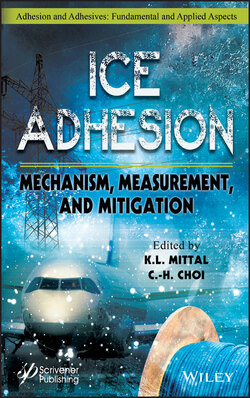Читать книгу Ice Adhesion - Группа авторов - Страница 27
1.4.3 Parameters Affecting the Friction Coefficient of Ice In the following subsection the effect of each important parameter on the coefficient of friction of ice is discussed. Particularly, the important parameters will be presented through their relationship to the thickness of the pertinent liquid-like lubricating layer.
ОглавлениеLet us first consider the effect of temperature. After having analyzed the friction regime diagram of Figure 1.13(b), it is not surprising that some studies have found a decrease in the coefficient of friction with increasing temperature, while others have observed the opposite [133]. When the ice-solid translation is occuring within the boundary friction regime the coefficient of friction will indeed first decrease with increasing temperature, but will begin to rise again as the temperature approaches 0°C. The minimum coefficient of friction will be obtained at temperatures between -2°C and -7°C, depending on the measurement method, the normal load on the slider, the linear sliding velocity, and the material of the slider [133]. At low temperatures, the lubricating film will be thin and the friction will be dominated by solid-solid interactions. This type of friction is typical of the regimes to the left of the minimum in Figure 1.13(b). As the temperature is increased, and approaches the melting point temperature, the lubricating liquid-like layer will thicken. As the liquid-like layer becomes thick enough to support the slider, friction will decrease with lessened solid-solid interactions, then increase with the buildup of capillary bridges. This type of friction is typical of the region to the right of the minimum in Figure 1.13(b), that is, the mixed friction regime, with a further increase in film thickness leading to the hydrodynamic regime.
Next, let us consider the effect of the sliding velocity, v. Numerous reports have been published on the coefficient of friction decreasing with increasing sliding velocity [133]. Naturally, higher velocities will lead to more frictional heat than lower velocities which results in greater melt water production. Within the boundary friction regime and into the mixed friction regime, the increased thickness of the liquid-like layer results in more lubrication.
Eventually, as shown in Figure 1.13(b), drag forces will begin to outweigh the benefits of decreased solid-solid contact as the sliding surfaces enter the hydrodynamic friction regime. Within the boundary regime, the coefficient of friction has been shown to be dependant on the velocity of the slider with [133]. Once drag forces begin to significantly contribute to the force of friction in the hydrodynamic regime, the scaling of the friction coefficient with sliding velocity changes drastically. The increase in drag forces from shearing the lubricating layer lead to increases in friction. Oksanen and Keinonen found that the coefficient of friction increases with increased sliding velocity for temperatures close to the melting point, with [151].
The effects of the applied normal force and the actual area of contact between the slider and the ice are inextricably linked. Under dry friction conditions, as shown schematically in Figure 1.13(a), an increase in the normal force will lead to more asperities coming into contact, and thus an increase in the friction force of the system. However, in the case of ice friction, it is generally accepted in literature that the coefficient of friction of a slider mated with ice decreases with increased applied normal force at a given temperature and slider velocity [133]. The increased normal force leads to increased actual area of contact between the asperities of the ice and the slider. The greater amount of contact points contribute to frictional heating which, in turn, will result in a thicker lubricating liquid-like layer. The coefficient of friction has been reported to become independent of the applied force with larger contact areas [133]. Under these conditions (and when the temperature approaches the melting point), the thickness of the lubricating liquid-like layer is such that complete wetting of the slider occurs. The slider-ice system is now in the hydrodynamic regime, where shearing of the liquid-like layer dominates in determining the force of friction [133]. Amonton correctly attributed friction to the roughness of surfaces in 1699 [127]. Generally, in the dry friction and boundary friction regimes, increased surface roughness leads to more contacting asperities between mated surfaces and thus requires the cleaving of more solid-solid bonds to slide the surfaces relative to one another. Various reports have been published which conclude that roughening the slider surface indeed increases the coefficient of friction on ice [133]. However, as discussed in Section 1.3.1, surface roughness and wettability are intimately linked. Surfaces of high roughness can exhibit high hydrophobicity through the trapping of air in their asperities. As such, Kietzig et al. (2009) have shown that laser irradiated stainless steel sliders which possess hierarchical hydrophobic surface roughness demonstrate lower coefficients of friction throughout the mixed friction and hydrodynamic friction regimes [152]. In the mixed and hydrodynamic friction regimes, a surface which is less easily wetted will result in less capillary bridges between the slider and the ice. However, the effect of surface hydrophobicity cannot be investigated independantly of other inherent material properties such as thermal conductivity and material hardness without affecting properties such as surface roughness.
Finally, the relative humidity of the surrounding environment has been shown to have a strong effect on the onset of the sliding movement. That is, the higher the humidity, the more lubricated is the interface between the slider and the ice, and thus the lower the frictional resistance [153].
